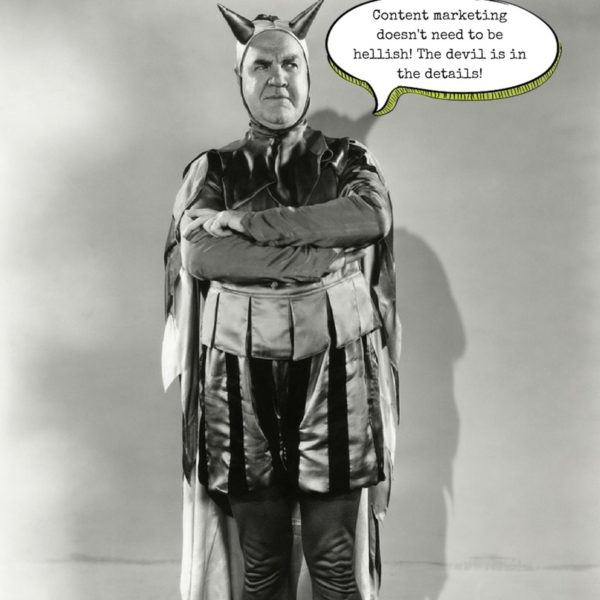Tales of Content Horror: How to Exorcise Your Content Marketing
 Reading Time: 5 minutes
Reading Time: 5 minutesContent marketing “ninjas” are the 2016 equivalent of social media “gurus”
Writing a blog or two, posting on Instagram and Snap, and speaking at a conference seems to be the new M.B.A. of Content Marketing. One doesn’t need to have a track record of delivering ROI, or experience managing the sales funnel, or proper use of a tech stack to put on the ninja costume, run a series of seminars, and advise on what to post. (By the way, if you don’t know what a sales funnel or a tech stack are, that’s fine. After all…why would you? See below for plain English explanations.)
This post is a great example of content marketing. Although it is educational and hopefully inspirational, it may also compel you to find out who I am and what I do. You may want to read other articles I’ve written or even meet me in the real world. Writers and publishers are using content to build relationships and loyalty.
The truly scary thing is that small- and mid-sized business owners are getting all kinds of poison in their sites (or the proverbial razor blade in the apple) that will ultimately drive away legitimate prospects. The word “persona” seems to have taken the place of “human being.” We are real life flesh-and-blood people who have choices of what to read, which sites to visit, who to chat with (live and via a bot), and ultimately where to spend our money.
Says Jim D’Arcangelo, VP of Marketing of When I Work, “Great content, done well, has the potential to bond a customer or prospect’s relationship and understanding of the “selling” company in unprecedented ways. Great content delivers “appreciated” reach, rich brand positioning and messaging, contextual and meaningful engagement, and non-intrusive, insightful calls to action, when desired by the buyer – all delivered as they want it, where they want it, in the format they want. Unfortunately, the vast majority of companies just sling content against the wall and see what sticks…with little understanding of what stinks.”
My intention is not to frighten you (although alarmist content tends to drive readership). I want to help you develop a content strategy that works for your business and your prospects.
Here are 7 of the scariest things I’ve seen/heard lately in the content marketing space:
-
Let’s start with the numbers — content marketing spend is on the rise among companies of all sizes, but a whopping 71% of big companies (who can afford precise tracking systems) say they don’t know how to measure it. It sounds like a John Oliver riff — “I don’t know exactly what it is or what it does, but everyone else is doing it so I’m just gonna spend a crap-ton of budget on it!”
-
Narcissism abounds. Many companies are still busily posting about themselves. Look at us…here’s our stuff…here’s more stuff. That’s a sales pitch. That’s not quality content. Great content is created around YOU…the reader. What do you want? What do you need? How much time do you have to spend reading? Do you like words or pictures? Instagram or LinkedIn? Know your target audience. Adds Rob Levin, CEO of RSL Media, “Act like a media company. Why? Because media companies have want you are aiming for: trust with their audience. How? Create content that help your customers solve their problems. Do that and they will be receptive to your marketing pitches.”
-
Companies are still hiring technical types rather than writers and journalists. Although digital skills are important, knowing how to code does not make someone a great content strategist. It would be like the Wall Street Journal requiring a senior writer to take a speed-typing test or demonstrate his ability to download apps on an iPhone. Smart people can figure out which buttons to push. Knowing what to say and when to say it is a talent that takes experience and a proven track record (of readership and analytics) to cultivate.
-
Gated content is being over-used. You start reading an article. You get engrossed. And all of a sudden, a gated goblin pops up in your face and asks for your e-mail address so he can send you a white paper. It’s like being on a date and halfway through your soup your suitor asks, “Wanna do XXX to me right now?” You’re still getting to know the content provider. Woo your prospect before you go in for hook-up!
-
Content isn’t integrated. This has been a problem for a long time. You need to start with your brand personality…and your target market. THEN you can start thinking about which media is best for which messages. Although the media has changed over time, knowing who you are and who you’re talking to will never go out of style.
-
Speaking of who you’re talking to…you probably wouldn’t show up at a church or synagogue Halloween party dressed as a hooker (unless your place of worship was VERY progressive). Your content needs to be tailored to your target market. That applies not just to content, but to length of copy (depending on where your prospects are in the buying cycle), type of content, and frequency of messaging — not to mention when you hit them with the “gated” stuff.
-
Let’s end with the numbers. The dilemma in the content marketing world is that there are “word and picture people” (who love to write, create memes, and spew out large volumes of content) and then there are “ROI people” (who look at every dollar of marketing spend and how it’s ultimately delivering on new business. The two groups are just starting to speak each other’s languages and work together to rescue that 71% that’s sitting in the dark, afraid that if they don’t “do” content marketing they won’t be cool or trending. And then there are folks like me…I don’t wear a costume or purport to be a content guru/ninja/rock star/Nurse Nancy. I just do what I do and hand out “treats” (i.e., ROI) rather than tricks on Halloween and all year round. (OK…I admit…I’m now guilty of #2…but a little bit of it is OK in certain circumstances.)
Want more content marketing “treats?” Ring my doorbell, please!
Definitions:
The sales funnel: Also called a purchase funnel, it defines the steps someone goes through from being a prospective customer to ultimately buying (and maybe even re-buying or expanding a relationship). How you treat and talk to each group from top to bottom will influence the outcome. Making sure prospects flow through the funnel quickly and cost-effectively should be a goal. (But don’t force them through the funnel!)
Marketing Technology Stack (aka Tech Stack or Martech Stack): Simply put, it’s the combination of automation systems that enable you to monitor and measure the effectiveness of your content marketing programs and focus your resources on the most productive techniques and leads. It ranges from very simple tools to super-complex and costly Enterprise solutions. This is the scariest chart ever of all the options currently available. As the industry grows up, I expect the number of options will shrink and industry consolidation will occur. The “unwrapped candy” as it were will get thrown away by selective buyers.
Adds D’Arcangelo, “Tech stacks, used with a purpose, are powerful means of hyper-targeting audiences, measuring content reach and yield, as well as attribution (to deal, rep, and channel level in the B2B space), optimizing SEO best approaches, and integrating content and design elements, calls to action, and medium. Tech stacks exist to ensure content accountability to both ‘reader’ and company.” In short, they help you deliver the right content to the right people and help you REALLY understand which of your content and contributors are making the proverbial cash register ring.

